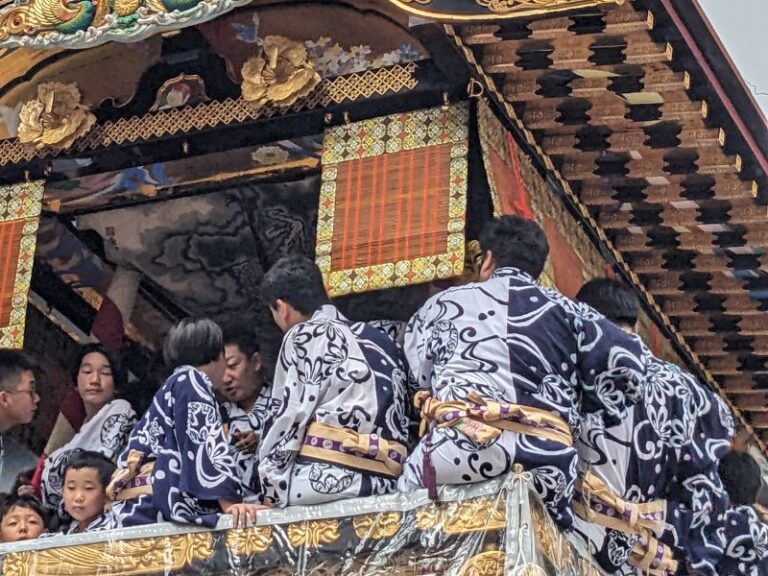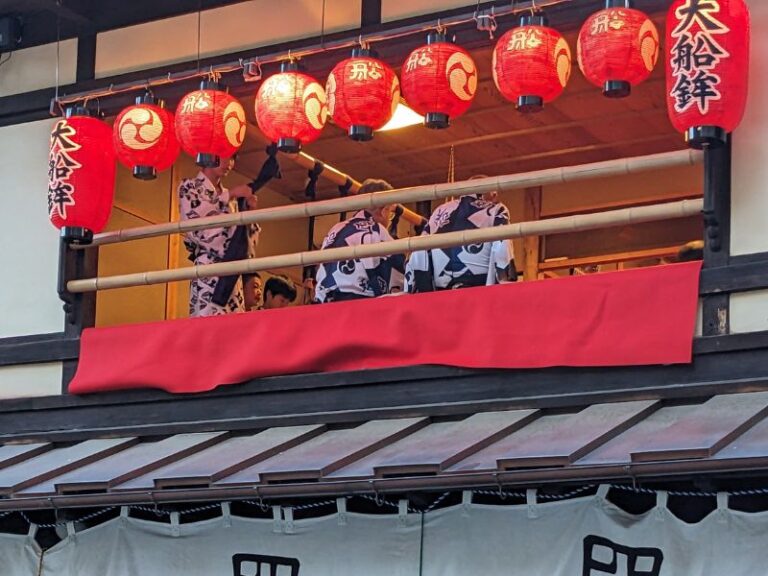A guest blog by Cathy Hughes, Zusetsu.
All blog images by Cathy Hughes.
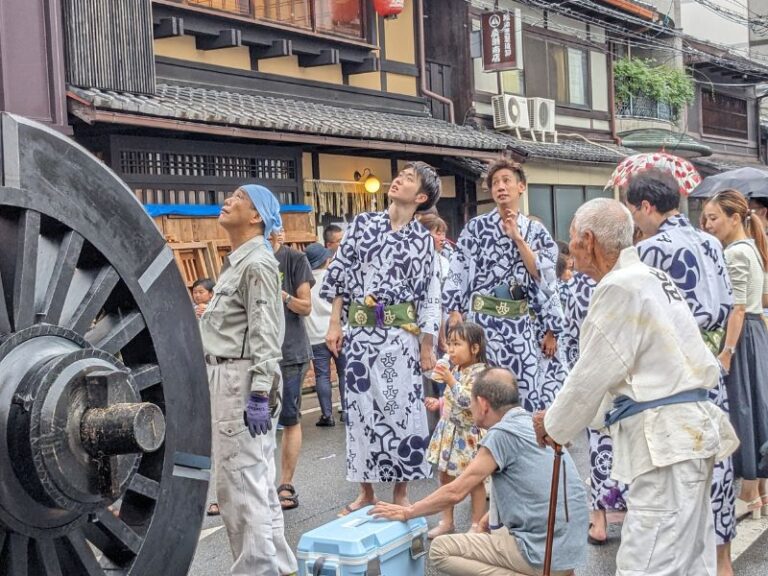
Rooted in community: community members watch others decorate the Iwato Yama float.
I’ll never forget the evocative, hypnotic sound of the Gion Festival music. I loved walking the evening streets in Kyoto on a warm summer night with the sound of the flutes and drums and bells weaving its way through me.
It is easy to accept that the sound may have originated to induce a trance-like state. Certainly, it would be effective in gaining the attention of the deities in order to pray for help in an ancient city besieged by illness.
Kyoto appears to me to be a city of two halves: there is the modern city of everyday traffic, work, sightseers, and stores. And there is another side, where you feel like you are stepping through a veil, and the city becomes timeless, and the distance between people and gods appears to be very thin.
I sat with my Kyoto friend in a regular café chatting after tea ceremony, when she said that she would check the calendar to see if a particular date we had arranged was auspicious. This simple comment threw me back 1000 years to when the citizens of the Kyoto Imperial Court organised their lives around the annual calendar: marking everything with a kind of feng shui notion of auspiciousness or otherwise.
It is that ancient calendar that has given us many of the festivals that are peppered throughout the Kyoto year, the most prominent of which is the Gion Matsuri.
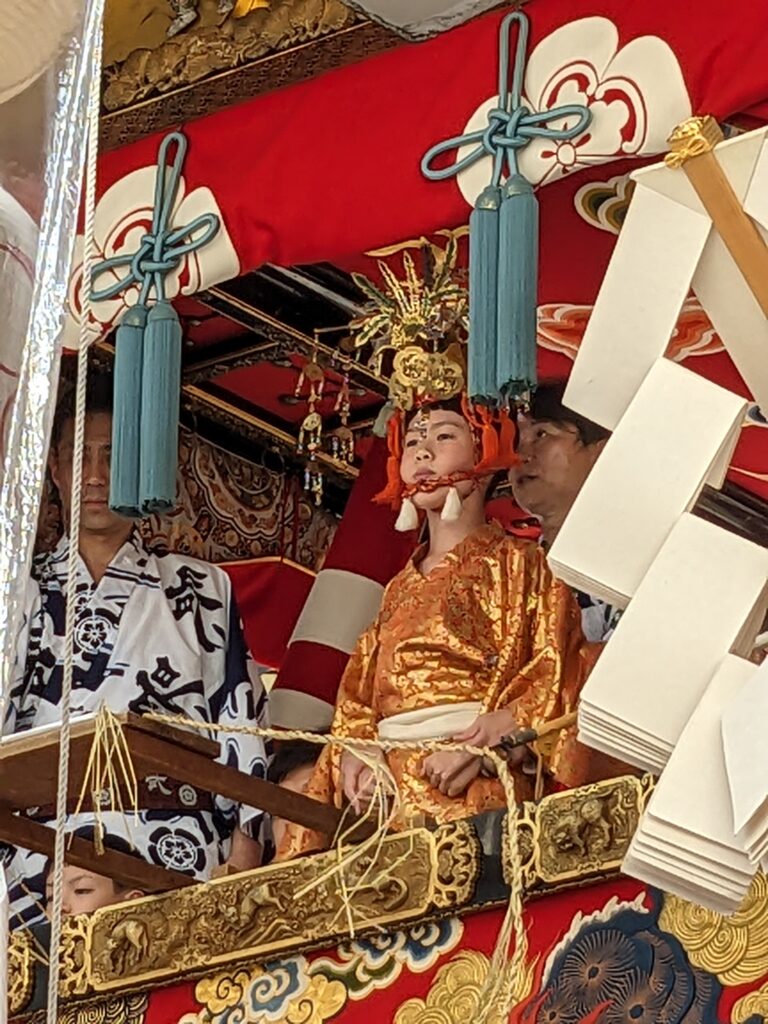
Catherine’s indispensable guidebook, The Gion Festival: Exploring its Mysteries, takes you deeper inside this beguiling festival, towards its heart, where you come to understand the enormous commitment by the communities of Gion, and you begin to see the sparkling weave of connection with an unseen world.
In Catherine’s work we see that the tall spires of the floats act like lightning rods for the spirits to come to the streets of Kyoto. And we learn of the connection between the enchanting music and dance for the pleasure of the resident Yasaka Shrine gods, the most prominent of whom is Susanoo-no-Mikoto, god of storms and brother to the Sun Goddess herself.
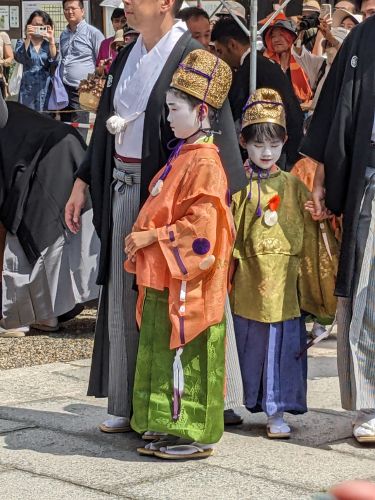
The Ayagasa Boko community and their young chigo boys visit Yasaka Shrine for a ritual blessing.
Kikusui Boko musicians prepare for a session during the Gion Festival.
Ōfune Boko community members at their yamaboko float’s meeting place.
There were many astonishing moments for me when I visited the saki matsuri – the earlier week of the Gion Festival – last summer. There were the dances for the resting gods at Yasaka Shrine, including the sagi odori dance with its costume of heron headwear and articulated wings; the hushed courtyard of Yasaka Shrine with the lights extinguished, as a priest transported the god to the portable mikoshi shrine under starlight; and Yasaka Shrine as a procession arrived bringing the chigo festival boys to a spiritual ceremony – the procession looked like a swaying, living Heian manuscript artwork as it approached.
The chigo fascinated me, chosen boys believed at one time to be pure vessels and communication conduits for the gods.
Catherine’s book introduced me to chimaki, the rice-straw amulets that hang above Kyoto doorways for protection from illness. It took me to tea ceremony beside a yamaboko float. I discovered a float dedicated to one of my favourite Heian poets, Izumi Shikibu, and the paper plum blossoms which are made painstakingly by the women of the local community.
Gion Festival 2025: A Summer Night of Senses and Spirit
As the Gion Matsuri returns for Gion Festival 2025, Kyoto’s streets once again shimmer with the timeless allure of this iconic Japanese festival. The scent of sizzling street food fills the air, mingling with delicate wafts of temple incense, as paper lanterns flicker like fireflies in the summer breeze. It’s in these moments that the culture of Japan feels most alive and opens a portal into the city’s soul. With each moment of Gion Matsuri, the city drifts deeper into enchantment.
Visit Gion Matsuri with Catherine’s book, and then later, when the flutes and bells and drums aren’t ringing in your ears so loudly, take it off the shelf once more and read it. The deep knowledge of the festival history and spirituality will reward and refresh you all over again.
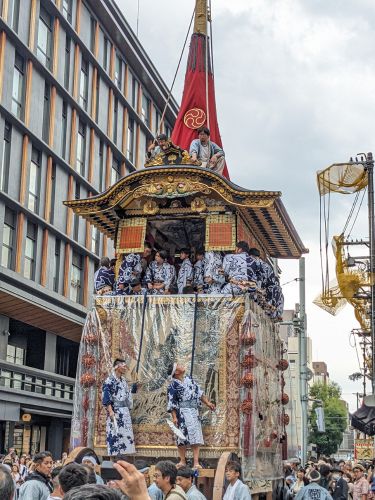
Kikusui Boko prepares for the yamaboko junko procession on July 17.
About Cathy Hughes and Zusetsu
Cathy Hughes is the founder of Zusetsu, an online store based in the Cotswolds, UK, which offers contemporary gifts from Kyoto. At the heart of our store are beautiful gift-wrapping furoshiki, tenugui art wall-hangings, hand-printed origami, and original woodblock prints.
Besides founding and running Zusetsu, Cathy Hughes is a professional children’s book illustrator keen to connect with the skilled artisans of this historic city. Cathy designs the Zusetsu range of furoshiki and tenugui, including Snowflower which is printed by hand in Kyoto.
Our Zusetsu blog aims to discover more about the beguiling old capital, pursuing our interests in tea ceremony, Heian history and literature, geiko traditions and dance, myth, the restoration of machiya town houses, festivals, and more.
Our Zusetsu community come together online every winter from all over the world, for our annual JanuaryInJapan Book Club.
We work with luxury brands, hosting corporate furoshiki and tenugui wrapping workshops and events, and provide corporate and wedding gift wrapping.
Website: www.zusetsu.com
Follow us on Instagram: @zusetsu_store
